中国全科医学 ›› 2024, Vol. 27 ›› Issue (04): 493-501.DOI: 10.12114/j.issn.1007-9572.2022.0902
所属专题: 肿瘤最新文章合辑; 消化系统疾病最新文章合辑; 数智医疗最新文章合辑
董娜1,2, 崔婷1,2, 王露露1,2, 师荣慧1,2, 冯洁2, 黄晓俊2,*( )
)
收稿日期:2022-12-29
修回日期:2023-07-04
出版日期:2024-02-05
发布日期:2023-11-09
通讯作者:
黄晓俊
基金资助:
DONG Na1,2, CUI Ting1,2, WANG Lulu1,2, SHI Ronghui1,2, FENG Jie2, HUANG Xiaojun2,*( )
)
Received:2022-12-29
Revised:2023-07-04
Published:2024-02-05
Online:2023-11-09
Contact:
HUANG Xiaojun
摘要: 背景 近年来有关将人工智能(AI)应用于胃癌诊治的研究日益增多,但目前尚未有研究者使用文献计量学分析法对其进行系统的分析。 目的 对将AI应用于胃癌诊治的相关研究进行分析,探讨2003—2022年研究的热点及发展趋势。 方法 于2022-11-06,计算机检索Web of Science(WOS)核心合集数据库,获取将AI应用于胃癌诊治的相关研究。通过文献计量学分析法,采用VOSviewer 1.6.18软件对国家(地区)间、机构间、作者间的合作情况、共被引作者情况、关键词共现与叠加情况进行可视化分析,采用CiteSpace 5.7.R5软件进行机构中介中心性分析、期刊双图叠加分析、近6年共被引文献聚类分析、共被引文献聚类时间线图分析及参考文献突现分析。采用Excel 2019软件绘制发文量条形图,以及国家(地区)、机构、期刊、作者、共被引作者、引用参考文献和关键词的描述性分析表格。 结果 共纳入703篇文献,2003—2022年将AI应用于胃癌诊治的相关研究年发文量整体呈上升趋势,2017年后年发文量快速增长,其中2019—2021年增长最为迅速。发文量最多的国家(地区)、机构和作者分别为中国、中国科学院和TADA TOMOHIRO。共被引次数排在前3的作者BRAY FREDDIE、HIRASAWA TOSHIAKI和JIANG YUMING对该领域做出了重要贡献。Frontiers in Oncology是发文量最多的期刊,Gastrointestinal Endoscopy是刊载将AI应用于胃癌诊治相关研究、发文量排在前10的期刊中最具影响力的期刊。施引期刊的所属领域主要集中在"Medicine,Medical,Clinical"("药物,医学,临床")、"Molecular,Biology,Immunology"("分子,生物学,免疫学")2个领域;被引期刊的所属领域主要集中在"Molecular,Biology,Genetics"("分子,生物学,遗传学")、"Health,Nursing,Medicine"("健康,护理,药物")2个领域。共被引次数排在首位的参考文献为Global cancer statistics 2018:GLOBOCAN estimates of incidence and mortality worldwide for 36 cancers in 185 countries。根据关键词聚类结果可将所有关键词分为4类:AI辅助胃癌的生物学研究、AI辅助胃癌的内镜诊断、AI辅助胃癌的病理诊断和AI辅助胃癌的非内镜治疗及预后预测。深度学习、卷积神经网络、影像组学、消化道内镜、病理学和免疫治疗是目前的研究热点。 结论 AI在胃癌诊治中具有广阔的应用前景,越来越多的学者致力于开展胃癌诊治的AI研究。目前,AI在胃癌的生物学、诊断、分期、疗效评估和预后预测方面得到了广泛的研究。本研究结果可为从事AI与胃癌相关研究工作的学者提供参考。
| 排名 | 国家(地区) | 发文量(篇) | 占比(%) | 总被引用次数(次) | 平均被引用次数(次) | TLS |
|---|---|---|---|---|---|---|
| 1 | 中国 | 366 | 50.063 | 4 371 | 11.94 | 1 272 |
| 2 | 美国 | 93 | 13.229 | 2 704 | 29.08 | 724 |
| 3 | 韩国 | 86 | 12.233 | 890 | 10.35 | 438 |
| 4 | 日本 | 79 | 11.238 | 2 232 | 28.25 | 905 |
| 5 | 德国 | 47 | 6.686 | 1 189 | 25.30 | 527 |
| 6 | 英国 | 29 | 4.125 | 839 | 28.93 | 322 |
| 7 | 印度 | 24 | 3.413 | 226 | 9.42 | 76 |
| 8 | 荷兰 | 17 | 2.418 | 869 | 51.12 | 259 |
| 9 | 意大利 | 17 | 2.418 | 252 | 14.82 | 227 |
| 10 | 巴基斯坦 | 17 | 2.418 | 165 | 9.71 | 124 |
表1 发文量排在前10的国家(地区)的发文情况(截至2022-11-06)
Table 1 Top 10 countries(regions)in term of publication volume
| 排名 | 国家(地区) | 发文量(篇) | 占比(%) | 总被引用次数(次) | 平均被引用次数(次) | TLS |
|---|---|---|---|---|---|---|
| 1 | 中国 | 366 | 50.063 | 4 371 | 11.94 | 1 272 |
| 2 | 美国 | 93 | 13.229 | 2 704 | 29.08 | 724 |
| 3 | 韩国 | 86 | 12.233 | 890 | 10.35 | 438 |
| 4 | 日本 | 79 | 11.238 | 2 232 | 28.25 | 905 |
| 5 | 德国 | 47 | 6.686 | 1 189 | 25.30 | 527 |
| 6 | 英国 | 29 | 4.125 | 839 | 28.93 | 322 |
| 7 | 印度 | 24 | 3.413 | 226 | 9.42 | 76 |
| 8 | 荷兰 | 17 | 2.418 | 869 | 51.12 | 259 |
| 9 | 意大利 | 17 | 2.418 | 252 | 14.82 | 227 |
| 10 | 巴基斯坦 | 17 | 2.418 | 165 | 9.71 | 124 |
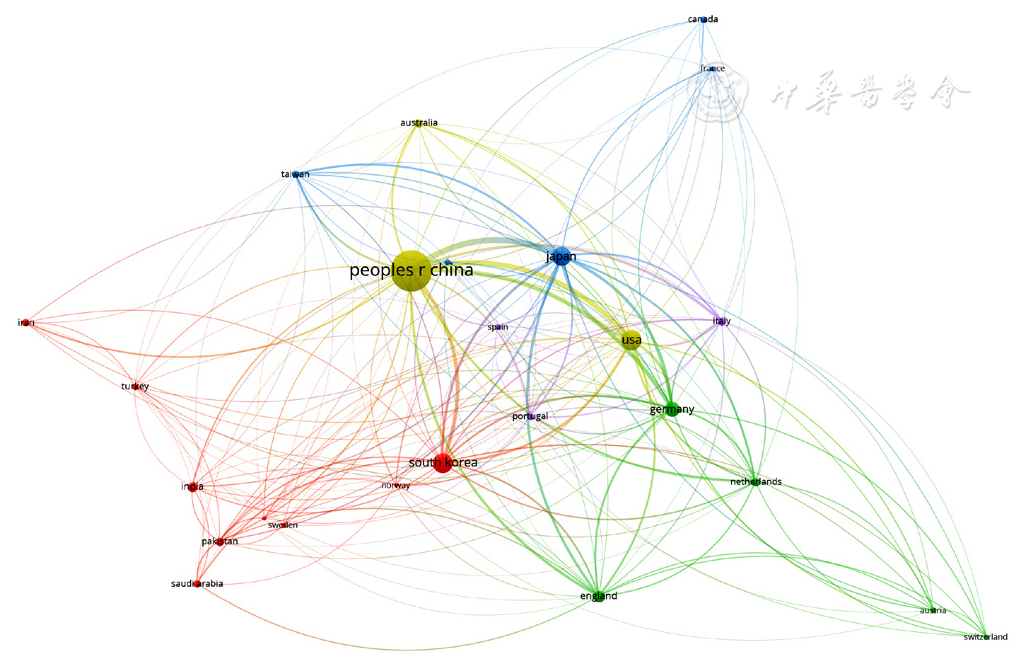
图2 国家(地区)间的合作网络图谱注:节点表示国家(地区);节点大小表示发文量的多少,节点越大表示发文量越多;节点的颜色表示国家(地区)所属的聚类;节点之间的线条表示存在合作关系,线条越粗表示关系越紧密。
Figure 2 Mapping of collaborative networks among countries(regions)
| 排名 | 机构 | 国家(地区) | 发文量(篇) | TLS | 总被引用次数(次) |
|---|---|---|---|---|---|
| 1 | 中国科学院 | 中国 | 32 | 392 | 492 |
| 2 | 中山大学 | 中国 | 25 | 283 | 532 |
| 3 | 上海交通大学 | 中国 | 25 | 122 | 434 |
| 4 | 中国科学技术大学 | 中国 | 24 | 337 | 369 |
| 5 | 武汉大学 | 中国 | 21 | 271 | 246 |
| 6 | 延世大学 | 韩国 | 20 | 106 | 205 |
| 7 | 南方医科大学 | 中国 | 19 | 176 | 293 |
| 8 | 南京医科大学 | 中国 | 19 | 96 | 117 |
| 9 | 成均馆大学 | 韩国 | 19 | 41 | 124 |
| 10 | 东京大学 | 日本 | 18 | 360 | 662 |
表2 发文量排在前10的机构的发文情况(截至2022-11-06)
Table 2 Top 10 institutions in term of publication volume
| 排名 | 机构 | 国家(地区) | 发文量(篇) | TLS | 总被引用次数(次) |
|---|---|---|---|---|---|
| 1 | 中国科学院 | 中国 | 32 | 392 | 492 |
| 2 | 中山大学 | 中国 | 25 | 283 | 532 |
| 3 | 上海交通大学 | 中国 | 25 | 122 | 434 |
| 4 | 中国科学技术大学 | 中国 | 24 | 337 | 369 |
| 5 | 武汉大学 | 中国 | 21 | 271 | 246 |
| 6 | 延世大学 | 韩国 | 20 | 106 | 205 |
| 7 | 南方医科大学 | 中国 | 19 | 176 | 293 |
| 8 | 南京医科大学 | 中国 | 19 | 96 | 117 |
| 9 | 成均馆大学 | 韩国 | 19 | 41 | 124 |
| 10 | 东京大学 | 日本 | 18 | 360 | 662 |
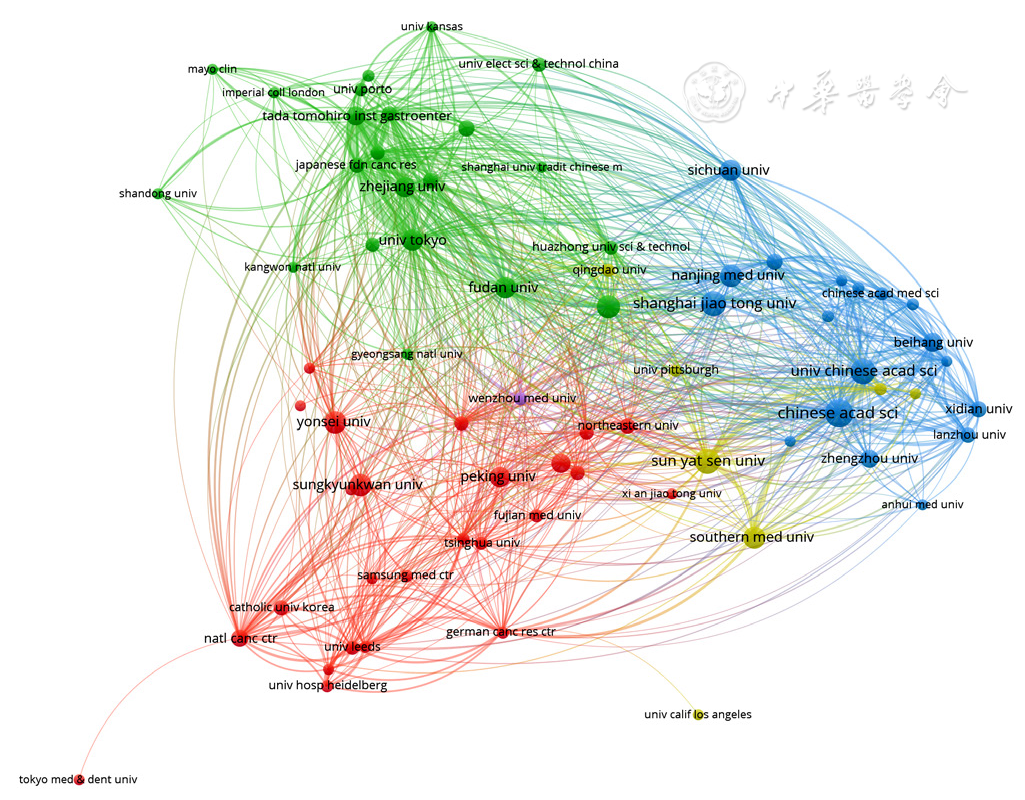
图3 机构间的合作网络图谱注:节点表示机构;节点大小表示发文量的多少,节点越大表示发文量越多;节点的颜色表示机构所属的聚类;节点之间的线条表示存在合作关系,线条越粗表示关系越紧密。
Figure 3 Mapping of collaborative networks among institutions
| 排名 | 期刊 | 国家(地区) | 发文量(篇) | 影响因子(2022年) | Journal Citation Reports(JCR)分区(2022年) | 被引用次数(次) |
|---|---|---|---|---|---|---|
| 1 | Frontiers in Oncology | 瑞士 | 32 | 5.738 | Q2 | 123 |
| 2 | Scientific Reports | 英国 | 21 | 4.996 | Q2 | 265 |
| 3 | Cancers | 瑞士 | 17 | 6.575 | Q1 | 28 |
| 4 | Gastrointestinal Endoscopy | 美国 | 15 | 10.396 | Q1 | 413 |
| 5 | World Journal of Gastroenterology | 中国 | 15 | 5.374 | Q2 | 98 |
| 6 | Gastric Cancer | 日本 | 14 | 7.701 | Q1 | 519 |
| 7 | Diagnostics | 波兰 | 12 | 3.992 | Q2 | 36 |
| 8 | Frontiers in Genetics | 瑞士 | 11 | 4.772 | Q1 | 37 |
| 9 | Computational and Mathematical Methods in Medicine | 英国 | 10 | 2.809 | Q2 | 49 |
| 10 | Digestive Endoscopy | 澳大利亚 | 9 | 6.337 | Q1 | 166 |
表3 发文量排在前10的期刊的发文情况及2022年评价指标情况(截至2022-11-06)
Table 3 Publications and evaluation metrics in 2022 of top 10 journals in term of publication volume
| 排名 | 期刊 | 国家(地区) | 发文量(篇) | 影响因子(2022年) | Journal Citation Reports(JCR)分区(2022年) | 被引用次数(次) |
|---|---|---|---|---|---|---|
| 1 | Frontiers in Oncology | 瑞士 | 32 | 5.738 | Q2 | 123 |
| 2 | Scientific Reports | 英国 | 21 | 4.996 | Q2 | 265 |
| 3 | Cancers | 瑞士 | 17 | 6.575 | Q1 | 28 |
| 4 | Gastrointestinal Endoscopy | 美国 | 15 | 10.396 | Q1 | 413 |
| 5 | World Journal of Gastroenterology | 中国 | 15 | 5.374 | Q2 | 98 |
| 6 | Gastric Cancer | 日本 | 14 | 7.701 | Q1 | 519 |
| 7 | Diagnostics | 波兰 | 12 | 3.992 | Q2 | 36 |
| 8 | Frontiers in Genetics | 瑞士 | 11 | 4.772 | Q1 | 37 |
| 9 | Computational and Mathematical Methods in Medicine | 英国 | 10 | 2.809 | Q2 | 49 |
| 10 | Digestive Endoscopy | 澳大利亚 | 9 | 6.337 | Q1 | 166 |
| 排名 | 期刊 | 国家(地区) | 共被引次数(次) | 影响因子(2022年) | JCR分区(2022年) |
|---|---|---|---|---|---|
| 1 | Gastrointestinal Endoscopy | 美国 | 1 004 | 10.396 | Q1 |
| 2 | Gastric Cancer | 日本 | 702 | 7.701 | Q1 |
| 3 | Endoscopy | 德国 | 631 | 9.776 | Q1 |
| 4 | Gut | 英国 | 501 | 31.793 | Q1 |
| 5 | Scientific Reports | 英国 | 487 | 4.996 | Q2 |
| 6 | Gastroenterology | 美国 | 454 | 33.883 | Q1 |
| 7 | PLoS One | 美国 | 401 | 3.752 | Q2 |
| 8 | Nature | 英国 | 387 | 69.504 | Q1 |
| 9 | CA:A Cancer Journal for Clinicians | 美国 | 383 | 286.130 | Q1 |
| 10 | World Journal of Gastroenterology | 中国 | 382 | 5.374 | Q2 |
表4 共被引次数排在前10的期刊的共被引情况及2022年评价指标情况(截至2022-11-06)
Table 4 Co-citations and evaluation metrics in 2022 of top 10 journals in term of co-citations
| 排名 | 期刊 | 国家(地区) | 共被引次数(次) | 影响因子(2022年) | JCR分区(2022年) |
|---|---|---|---|---|---|
| 1 | Gastrointestinal Endoscopy | 美国 | 1 004 | 10.396 | Q1 |
| 2 | Gastric Cancer | 日本 | 702 | 7.701 | Q1 |
| 3 | Endoscopy | 德国 | 631 | 9.776 | Q1 |
| 4 | Gut | 英国 | 501 | 31.793 | Q1 |
| 5 | Scientific Reports | 英国 | 487 | 4.996 | Q2 |
| 6 | Gastroenterology | 美国 | 454 | 33.883 | Q1 |
| 7 | PLoS One | 美国 | 401 | 3.752 | Q2 |
| 8 | Nature | 英国 | 387 | 69.504 | Q1 |
| 9 | CA:A Cancer Journal for Clinicians | 美国 | 383 | 286.130 | Q1 |
| 10 | World Journal of Gastroenterology | 中国 | 382 | 5.374 | Q2 |
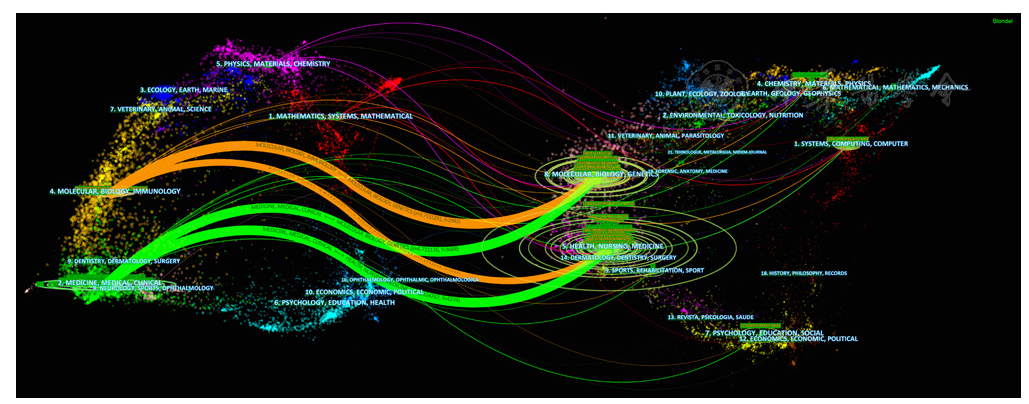
图4 基于施引期刊与被引期刊的双图叠加分析注:左侧为施引期刊聚类,右侧为被引期刊聚类;中间的曲线为引证曲线;椭圆纵轴越长表示期刊刊载论文越多,横轴越长表示作者的数量越多。
Figure 4 Double graph overlay analysis of citing and cited journals
| 排名 | 作者 | 国家(地区) | 发文量(篇) | 共被引作者 | 国家(地区) | 共被引次数(次) |
|---|---|---|---|---|---|---|
| 1 | TADA TOMOHIRO | 日本 | 16 | BRAY FREDDIE | 美国 | 186 |
| 2 | TIAN JIE | 中国 | 11 | HIRASAWA TOSHIAKI | 日本 | 122 |
| 3 | YU HONGGANG | 中国 | 10 | JIANG YUMING | 中国 | 111 |
| 4 | LI GUOXI | 中国 | 10 | WU LIANLIAN | 中国 | 106 |
| 5 | DONG DI | 中国 | 10 | HORIUCHI YUSUKE | 日本 | 81 |
| 6 | HIRASAWA TOSHIAKI | 日本 | 9 | ZHU YAN | 中国 | 81 |
| 7 | YU JIANG | 中国 | 9 | SHICHIJO SATOKI | 日本 | 79 |
| 8 | WU LIANLIAN | 中国 | 8 | MORI YUICHI | 日本 | 74 |
| 9 | LI CHEN | 中国 | 8 | SZEGEDY CHRISTIAN | 美国 | 71 |
| 10 | FUJISAKI JUNKO | 日本 | 7 | Japanese Gastric Cancer Association | 日本 | 70 |
表5 发文量和共被引次数排在前10的作者的发文情况(截至2022-11-06)
Table 5 Publication of top 10 authors in terms of pulication volume and total number of citations
| 排名 | 作者 | 国家(地区) | 发文量(篇) | 共被引作者 | 国家(地区) | 共被引次数(次) |
|---|---|---|---|---|---|---|
| 1 | TADA TOMOHIRO | 日本 | 16 | BRAY FREDDIE | 美国 | 186 |
| 2 | TIAN JIE | 中国 | 11 | HIRASAWA TOSHIAKI | 日本 | 122 |
| 3 | YU HONGGANG | 中国 | 10 | JIANG YUMING | 中国 | 111 |
| 4 | LI GUOXI | 中国 | 10 | WU LIANLIAN | 中国 | 106 |
| 5 | DONG DI | 中国 | 10 | HORIUCHI YUSUKE | 日本 | 81 |
| 6 | HIRASAWA TOSHIAKI | 日本 | 9 | ZHU YAN | 中国 | 81 |
| 7 | YU JIANG | 中国 | 9 | SHICHIJO SATOKI | 日本 | 79 |
| 8 | WU LIANLIAN | 中国 | 8 | MORI YUICHI | 日本 | 74 |
| 9 | LI CHEN | 中国 | 8 | SZEGEDY CHRISTIAN | 美国 | 71 |
| 10 | FUJISAKI JUNKO | 日本 | 7 | Japanese Gastric Cancer Association | 日本 | 70 |
| 排名 | 文献 | 期刊 | 第一作者 | 发表年份(年) | 共被引次数(次) |
|---|---|---|---|---|---|
| 1 | Global cancer statistics 2018:GLOBOCAN estimates of incidence and mortality worldwide for 36 cancers in 185 countries | CA:A Cancer Journal for Clinicians | BRAY FREDDIE | 2020 | 183 |
| 2 | Application of artificial intelligence using a convolutional neural network for detecting gastric cancer in endoscopic images | Gastric Cancer | HIRASAWA TOSHIAKI | 2018 | 113 |
| 3 | Application of convolutional neural network in the diagnosis of the invasion depth of gastric cancer based on conventional endoscopy | Gastrointestinal Endoscopy | ZHU YAN | 2019 | 78 |
| 4 | Convolutional neural network for the diagnosis of early gastric cancer based on magnifying narrow band imaging | Gastric Cancer | LI LAN | 2019 | 54 |
| 5 | A deep neural network improves endoscopic detection of early gastric cancer without blind spots | Endoscopy | WU LIANLIAN | 2019 | 52 |
| 6 | Dermatologist-level classification of skin cancer with deep neural networks | Nature | ESTEVA ANDRE | 2017 | 51 |
| 7 | Diagnostic outcomes of esophageal cancer by artificial intelligence using convolutional neural networks | Gastrointestinal Endoscopy | HORIE YOSHIMASA | 2018 | 48 |
| 8 | Computer-aided diagnosis for identifying and delineating early gastric cancers in magnifying narrow-band images | Gastrointestinal Endoscopy | KANESAKA TAKASHI | 2017 | 46 |
| 9 | Application of convolutional neural networks in the diagnosis of helicobacter pylori infection based on endoscopic images | EBioMedicine | SHICHIJO SATOKI | 2017 | 43 |
| 10 | Real-time artificial intelligence for detection of upper gastrointestinal cancer by endoscopy:a multicentre,case-control,diagnostic study | The Lancet Oncology | LUO HUIYAN | 2019 | 42 |
表6 共被引次数排在前10的参考文献的具体信息(截至2022-11-06)
Table 6 Detailed information on the top 10 references in term of co-citations
| 排名 | 文献 | 期刊 | 第一作者 | 发表年份(年) | 共被引次数(次) |
|---|---|---|---|---|---|
| 1 | Global cancer statistics 2018:GLOBOCAN estimates of incidence and mortality worldwide for 36 cancers in 185 countries | CA:A Cancer Journal for Clinicians | BRAY FREDDIE | 2020 | 183 |
| 2 | Application of artificial intelligence using a convolutional neural network for detecting gastric cancer in endoscopic images | Gastric Cancer | HIRASAWA TOSHIAKI | 2018 | 113 |
| 3 | Application of convolutional neural network in the diagnosis of the invasion depth of gastric cancer based on conventional endoscopy | Gastrointestinal Endoscopy | ZHU YAN | 2019 | 78 |
| 4 | Convolutional neural network for the diagnosis of early gastric cancer based on magnifying narrow band imaging | Gastric Cancer | LI LAN | 2019 | 54 |
| 5 | A deep neural network improves endoscopic detection of early gastric cancer without blind spots | Endoscopy | WU LIANLIAN | 2019 | 52 |
| 6 | Dermatologist-level classification of skin cancer with deep neural networks | Nature | ESTEVA ANDRE | 2017 | 51 |
| 7 | Diagnostic outcomes of esophageal cancer by artificial intelligence using convolutional neural networks | Gastrointestinal Endoscopy | HORIE YOSHIMASA | 2018 | 48 |
| 8 | Computer-aided diagnosis for identifying and delineating early gastric cancers in magnifying narrow-band images | Gastrointestinal Endoscopy | KANESAKA TAKASHI | 2017 | 46 |
| 9 | Application of convolutional neural networks in the diagnosis of helicobacter pylori infection based on endoscopic images | EBioMedicine | SHICHIJO SATOKI | 2017 | 43 |
| 10 | Real-time artificial intelligence for detection of upper gastrointestinal cancer by endoscopy:a multicentre,case-control,diagnostic study | The Lancet Oncology | LUO HUIYAN | 2019 | 42 |
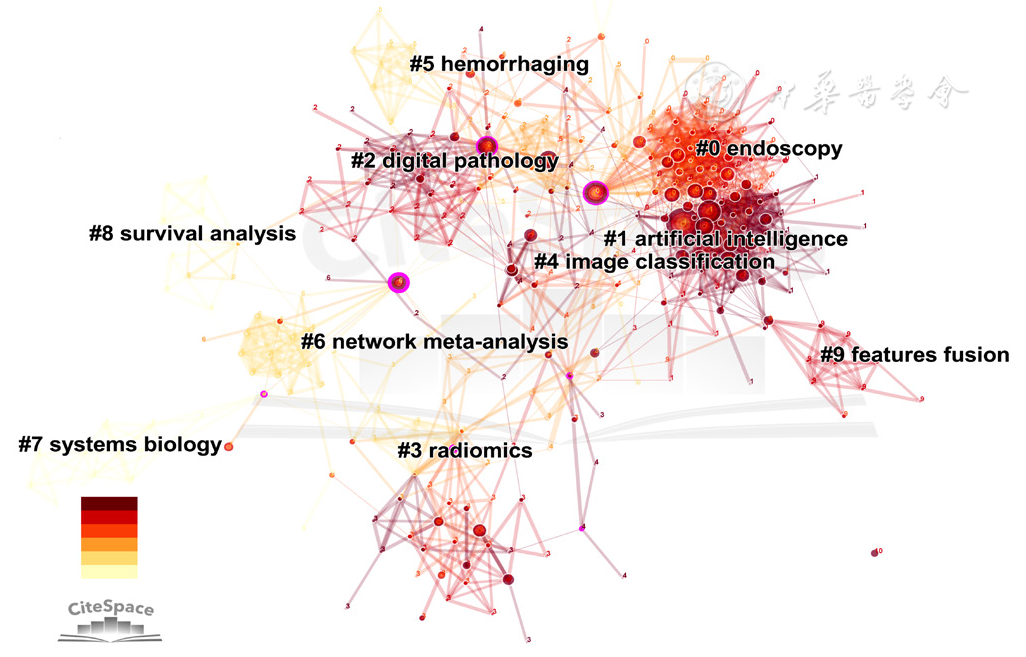
图7 近6年共被引文献聚类分析注:节点表示参考文献;节点大小表示共被引次数的多少,节点越大表示共被引次数越多;数字表示聚类的编号,数字越小表示聚类中包含的参考文献越多;节点颜色表示节点出现的时间,出现的时间越早,节点颜色越接近黄色,出现的时间越晚,节点颜色越接近红色;节点之间的线条表示存在共被引关系。
Figure 7 Clustering analysis of co-cited literature in the last 6 years
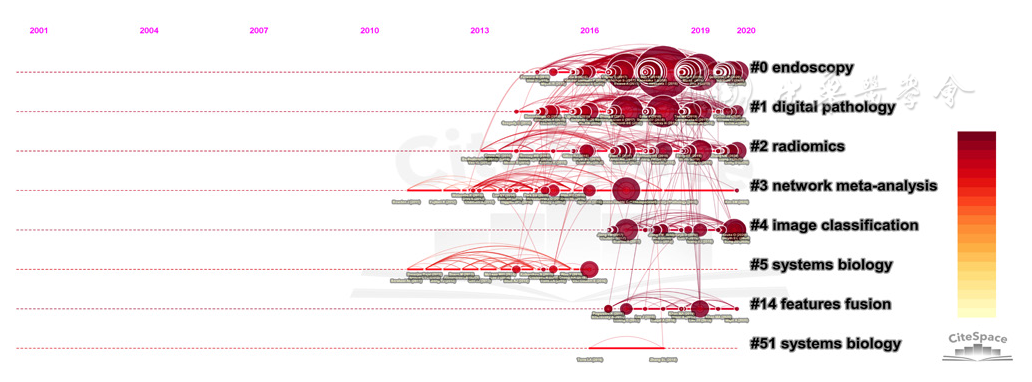
图8 共被引文献聚类时间线图注:节点表示参考文献;节点在横轴的上位置对应参考文献首次被引用的时间;圆圈越大表示参考文献共被引次数越多;节点颜色表示参考文献出现的时间,出现的时间越早,节点颜色越接近黄色,出现时间越晚,节点颜色越接近红色;右侧的聚类标签表示领域的主题。
Figure 8 Co-cited literature clustering timeline
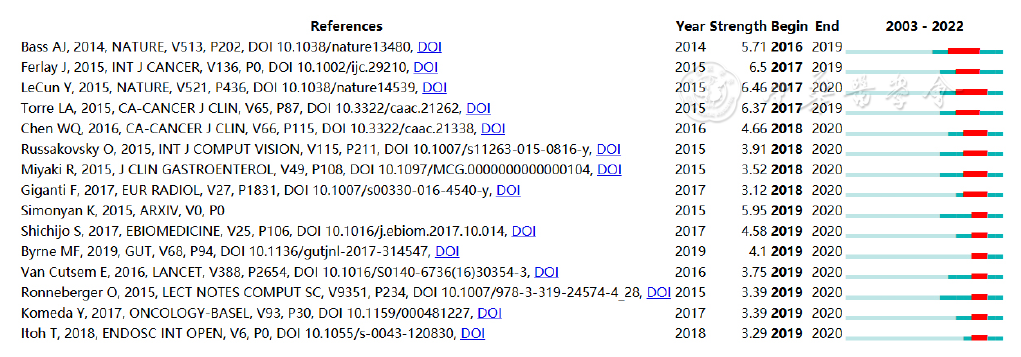
图9 突现力排在前15的参考文献突现信息注:References=参考文献,Year=参考文献出现时间,Strength=突现强度,Begin=突现开始的年份,End=突现结束的年份;浅蓝色条表示参考文献还未出现,深蓝色条表示参考文献开始出现,红色条表示突现时间段,红色条越长表示参考文献热度持续时间越久。
Figure 9 Top 15 reference with the strongest citation bursts
| 排名 | 关键词 | 出现频次(次) | TLS |
|---|---|---|---|
| 1 | gastric cancer | 218 | 844 |
| 2 | deep learning | 127 | 575 |
| 3 | artificial intelligence | 113 | 619 |
| 4 | classification | 111 | 488 |
| 5 | cancer | 108 | 364 |
| 6 | diagnosis | 104 | 476 |
| 7 | machine learning | 98 | 456 |
| 8 | endoscopy | 88 | 369 |
| 9 | expression | 68 | 366 |
| 10 | survival | 58 | 201 |
表7 出现频次排在前10的关键词的基本信息(截至2022-11-06)
Table 7 Basic information about the top 10 keywords in term of frequency
| 排名 | 关键词 | 出现频次(次) | TLS |
|---|---|---|---|
| 1 | gastric cancer | 218 | 844 |
| 2 | deep learning | 127 | 575 |
| 3 | artificial intelligence | 113 | 619 |
| 4 | classification | 111 | 488 |
| 5 | cancer | 108 | 364 |
| 6 | diagnosis | 104 | 476 |
| 7 | machine learning | 98 | 456 |
| 8 | endoscopy | 88 | 369 |
| 9 | expression | 68 | 366 |
| 10 | survival | 58 | 201 |
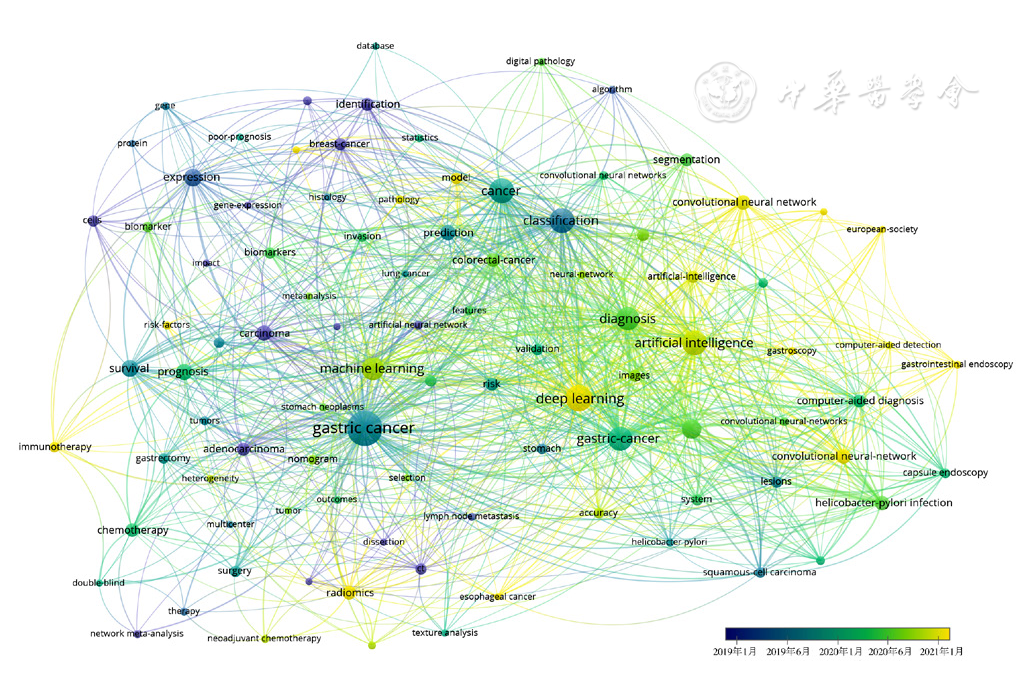
图11 关键词叠加图谱注:节点表示关键词;节点大小表示关键词出现频次的高低,节点越大表示关键词出现的频次越高;节点的颜色表示关键词出现的时间,颜色越接近蓝色表示关键词出现的时间越早,颜色越接近黄色表示关键词出现的时间越晚,是近年来的研究热点及前沿;节点之间的线条表示存在共现关系,线条越粗表示关系越紧密。
Figure 11 Mapping of keywords overlay
| [1] |
|
| [2] |
|
| [3] |
|
| [4] |
|
| [5] |
|
| [6] |
|
| [7] |
|
| [8] |
|
| [9] |
|
| [10] |
|
| [11] |
|
| [12] |
|
| [13] |
|
| [14] |
|
| [15] |
|
| [16] |
|
| [17] |
|
| [18] |
|
| [19] |
|
| [20] |
|
| [21] |
|
| [22] |
|
| [23] |
|
| [24] |
|
| [25] |
|
| [26] |
|
| [27] |
|
| [28] |
|
| [29] |
|
| [30] |
|
| [31] |
|
| [32] |
|
| [1] | 郑博月, 付积艺, 吴佳霏, 王珺, 李慧. 卡非佐米治疗多发性骨髓瘤的疗效及安全性研究[J]. 中国全科医学, 2025, 28(30): 3806-3814. |
| [2] | 张鹏, 刘力滴, 张颖, 杨梓钰, 刘长明, 唐以俊, 廖晓阳, 贾禹. 2024意大利《成人超重、肥胖和代谢合并症行为治疗抵抗的管理指南》解读与启示[J]. 中国全科医学, 2025, 28(30): 3747-3752. |
| [3] | 周启保, 罗潇, 陈玲, 曹俊达, 李菊香, 徐劲松, 苏海. 收缩压昼夜变异率联合正常RR间期标准差对冠心病诊断价值的临床研究[J]. 中国全科医学, 2025, 28(30): 3760-3765. |
| [4] | 李淏, 李沛瑾, 刘婷婷, 崔译元, 李思聪, 刘丽星, 冯利, 癌性疼痛中西医结合诊疗指南工作组. 癌性疼痛中西医结合诊疗指南[J]. 中国全科医学, 2025, 28(30): 3729-3740. |
| [5] | 贾高鹏, 陈秋雨. 老年急性ST段抬高型心肌梗死经皮冠状动脉介入治疗术后心绞痛复发风险预测模型构建和验证:基于CYP2C19相关基因检测[J]. 中国全科医学, 2025, 28(30): 3779-3786. |
| [6] | 张天宇, 于海搏, 陈飞, 李新, 张佳佳, 詹晓凯, 申曼, 汤然, 范斯斌, 赵凤仪, 黄仲夏. POEMS综合征全身系统性治疗疗效和安全性的Meta分析[J]. 中国全科医学, 2025, 28(27): 3447-3455. |
| [7] | 王亚静, 段晓阳, 侯冉, 黄娅婕, 史健. 表皮生长因子受体阳性非小细胞肺癌脑转移患者靶向联合治疗研究进展[J]. 中国全科医学, 2025, 28(26): 3328-3337. |
| [8] | 智从从, 李雪, 程一乘, 王孝龙, 郑丽华. 痔中西医结合诊疗指南(2025版)[J]. 中国全科医学, 2025, 28(26): 3217-3228. |
| [9] | 黄雨琳, 王浩云, 李燕梅, 萧雪英. 胃癌患者化疗期间症状群的范围综述[J]. 中国全科医学, 2025, 28(26): 3338-3344. |
| [10] | 王慧, 胡银环, 冯显东, 刘莎, 汪洋帆. 人工智能在心理干预中的应用:效果、挑战与前景[J]. 中国全科医学, 2025, 28(25): 3209-3216. |
| [11] | 牛奔, 朱晓倩, 杨辰, 梁万年, 刘珏. 基于CiteSpace的国内外医疗大语言模型研究热点演进及趋势分析[J]. 中国全科医学, 2025, 28(25): 3200-3208. |
| [12] | 潘琦, 任菁菁, 马方晖, 胡梦杰. 全科医师对AI辅助诊疗系统的认知与需求调查[J]. 中国全科医学, 2025, 28(25): 3127-3136. |
| [13] | 王汝朋, 南京, 胡奕然, 杨升华, 金泽宁. 三酰甘油-葡萄糖体质量指数对2型糖尿病合并急性心肌梗死行急诊经皮冠状动脉介入治疗术后患者慢血流/无复流的预测价值研究[J]. 中国全科医学, 2025, 28(24): 2985-2992. |
| [14] | 李苗秀, 朱博文, 孔令军, 房敏. 青少年脊柱侧弯保守治疗临床评估工具研究进展[J]. 中国全科医学, 2025, 28(24): 3079-3088. |
| [15] | 国家感染性疾病临床医学研究中心江西分中心, 江西省结核病重点实验室. 肺结核合并慢性乙型肝炎病毒感染者治疗专家共识[J]. 中国全科医学, 2025, 28(24): 2961-2967. |
| 阅读次数 | ||||||
|
全文 |
|
|||||
|
摘要 |
|
|||||





